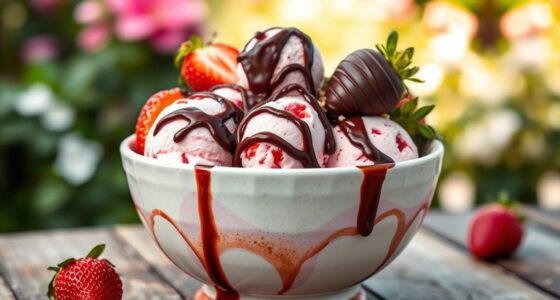Your ice cream likely has a grainy texture due to lactose crystallization and improper emulsification. High lactose levels can cause crystals to form, especially if the mix melts and refreezes, merging larger ice crystals. Inadequate emulsification can destabilize fats, leading to graininess. To improve this texture, you might need to adjust your ingredients and techniques. There are effective tips and creative uses to rescue grainy ice cream just ahead.
Key Takeaways
- Graininess often results from lactose crystallization due to high lactose levels exceeding solubility limits in the ice cream mixture.
- Melting and refreezing ice cream can merge smaller ice crystals into larger ones, creating a grainy texture.
- Insufficient emulsification can destabilize fat globules, leading to the formation of larger ice crystals.
- Fluctuating storage temperatures cause heat shock, which promotes the growth of larger ice crystals in ice cream.
- Incorporating stabilizers and ensuring proper emulsification can help prevent graininess and improve overall texture.
Understanding Grainy Ice Cream Texture
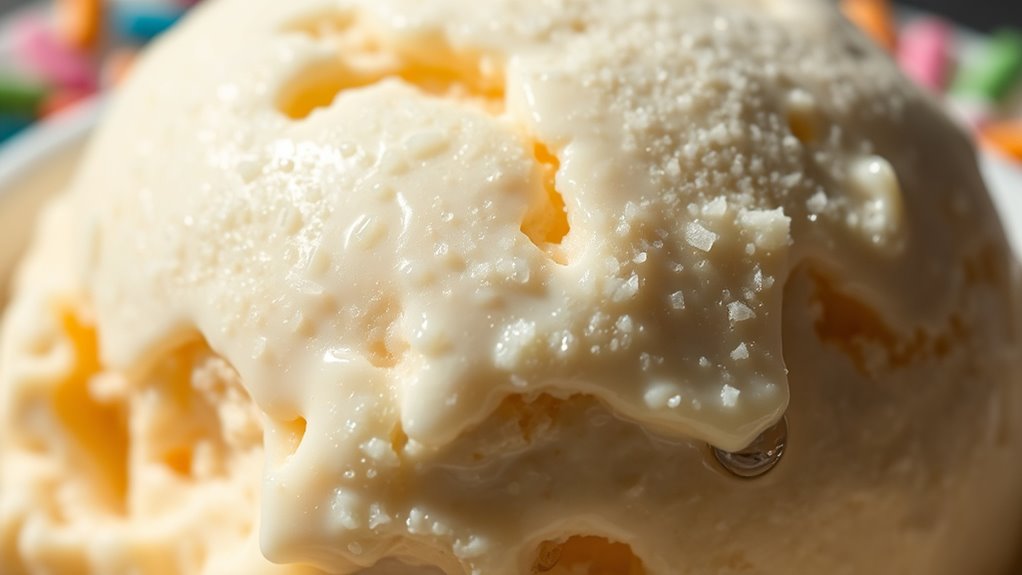
Grainy ice cream texture can be a real downer for your dessert experience. This unpleasant sensation often comes from lactose crystallization, especially when the lactose concentration in your ice cream exceeds its solubility limits.
When ice cream melts and refreezes, small ice crystals can merge into larger ones, worsening that gritty mouthfeel. You may notice minute particles forming, acting as nucleation sites that enhance the detection of these lactose crystals.
To avoid this, managing lactose levels is vital—selecting the right milk solids non-fat (MSNF) and total solids can help. Additionally, using appropriate stabilizers and minimizing high-lactose ingredients like whey solids can greatly reduce the risk of a grainy ice cream texture, ensuring a smoother and more enjoyable treat. Incorporating raw food diets into your overall nutrition may also lead to increased energy levels, which can make your ice cream experience even more delightful.
Causes of Graininess in Ice Cream
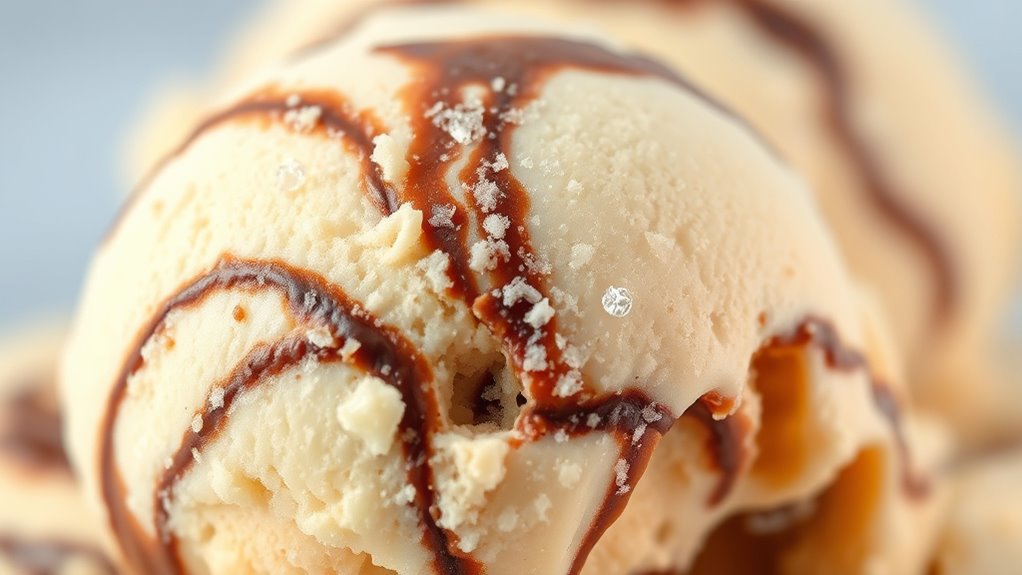
When ice cream melts and refreezes, it often leads to the development of graininess that can ruin your dessert experience. This graininess happens as small ice crystals merge into larger ones, creating an undesirable texture.
High lactose levels in the mix, especially with skimmed milk powder, can cause crystallization, contributing to a sandy feel. Additionally, insufficient emulsification during mixing may leave fat globules destabilized, leading to a lumpy or grainy consistency.
The presence of particulates, like flavorings or inclusions, can further exacerbate this issue if not managed well. Finally, storing ice cream at fluctuating temperatures causes heat shock, promoting the growth of larger ice crystals and resulting in a gritty texture when you serve it.
Importance of Proper Emulsification
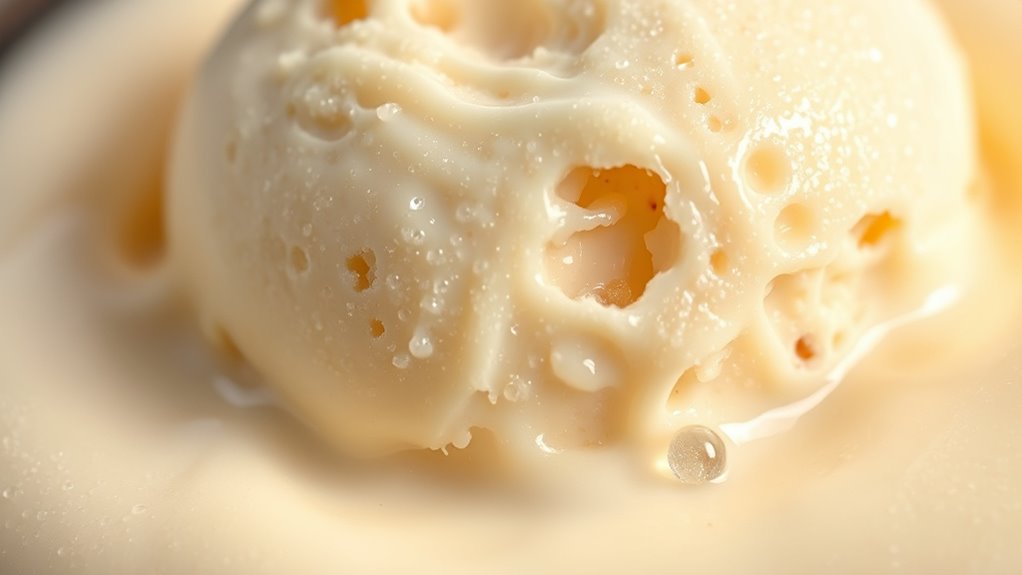
When you’re making ice cream, proper emulsification is key to achieving that smooth texture you desire.
Emulsifiers like lecithin and milk powder help bind fat and water, preventing large ice crystals from forming.
Emulsifiers’ Role in Texture
Emulsifiers play an essential role in achieving the smooth texture you expect in ice cream, as they bond with both water and fat to create a uniform mixture. By reducing the size of ice crystals, emulsifiers like lecithin and milk powder help maintain that creamy consistency. Proper emulsification prevents separation, ensuring a consistent distribution of ingredients throughout the ice cream mixture. Without it, larger ice crystals form during freezing, resulting in a grainy texture.
| Emulsifier Type | Function | Effect on Texture |
|---|---|---|
| Lecithin | Binds water and fat | Smooth, creamy texture |
| Milk Powder | Provides proteins | Enhances creaminess |
| Stabilizers | Slows ice crystal growth | Prevents graininess |
| Monoglycerides | Improves emulsion stability | Maintains texture balance |
| Polysorbates | Enhances mixture homogeneity | Reduces ice crystal size |
Churning Techniques for Smoothness
Achieving a smooth ice cream texture relies not just on the right ingredients but also on effective churning techniques. Proper emulsification is key, as it helps you distribute fat and water uniformly, preventing large ice crystals from forming. Emulsifiers like lecithin and milk powder bind with water, reducing ice crystal formation during storage. When you’re churning, keep an eye on the temperature; excessive agitation can lead to over-emulsification, resulting in a grainy texture similar to butter. Interestingly, the U.S. is the largest consumer of ice cream worldwide, which leads to continuous innovation in texture and flavor. Freshly squeezed juices, like orange juice, share a similar principle as they also require proper handling to maintain quality. Additionally, juice extraction from oranges maximizes vitamin C intake, which enhances the nutritional profile of juices.
Regularly check the mixture to verify it reaches the desired consistency, avoiding larger ice crystals that contribute to a gritty mouthfeel. If you use a blender before churning, you’ll enhance emulsification, leading to smaller ice crystals and a creamier final product. Additionally, it’s important to consider the high sugar and fat content in ice cream, as they can impact the texture and consistency if not balanced properly. Proper storage, akin to how freshly squeezed juices should be kept in airtight containers, can also help maintain ice cream’s smoothness over time.
Effects of Ice Crystal Formation
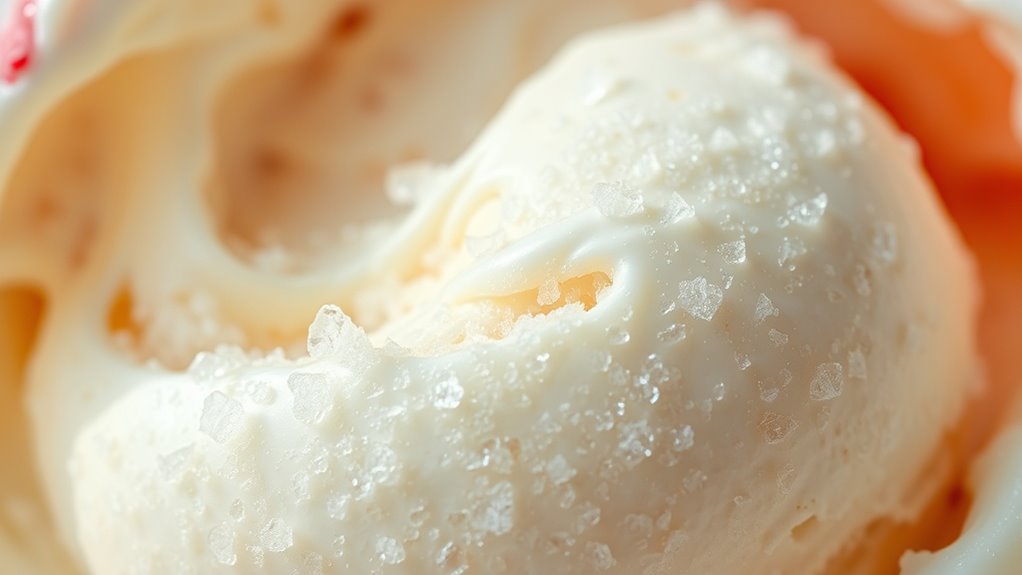
When you make ice cream, the size of the ice crystals can greatly affect its texture.
If the freezing process isn’t managed properly, larger ice crystals can form, leading to that unpleasant grainy feel.
Understanding how these crystals develop helps you create smoother, more enjoyable ice cream.
Ice Crystal Size
The size of ice crystals in your ice cream plays an essential role in determining its texture, influencing how creamy or grainy it feels on your palate.
Smaller ice crystals create a smooth, velvety mouthfeel, while large ice crystals lead to a grainy or icy texture. During the freezing process, rapid freezing helps form those desirable smaller ice crystals, whereas slower freezing allows larger ones to develop.
To enhance texture, emulsifiers and stabilizers like lecithin and guar gum can inhibit ice crystal growth by binding with water.
Additionally, maintaining a low draw temperature during production is vital, as higher temperatures can result in larger ice crystals, negatively impacting your ice cream experience.
Freezing Process Impact
While rapid freezing might seem like a minor detail, it greatly impacts the texture of your ice cream by influencing ice crystal formation.
If your homemade ice cream isn’t cooled quickly enough during the freezing process, water content can freeze into larger ice crystals. This results in that unwanted grainy texture instead of the smooth, creamy consistency you desire.
The rate of freezing is essential; faster freezing creates smaller ice crystals, while slower freezing allows larger ones to form.
Additionally, using unbalanced ingredients or high water content can worsen the situation. To achieve the best texture, focus on proper emulsification and consider adding stabilizers to minimize ice crystal formation for a delightful treat.
Tips for Preventing Grainy Ice Cream
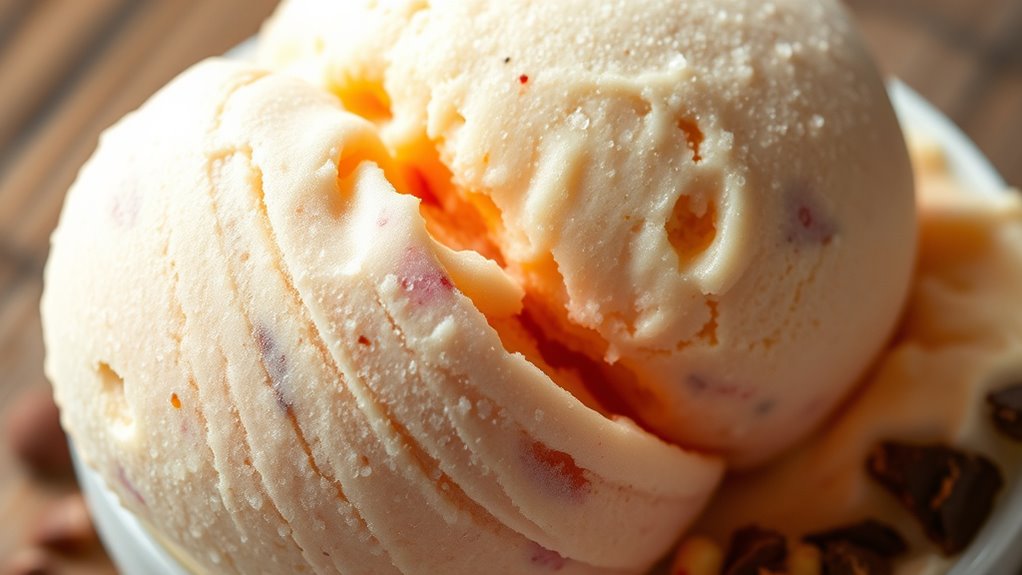
To achieve a smooth and creamy ice cream texture, it’s essential to start with a properly chilled mixture before churning. A colder base helps create smaller ice crystals during freezing, reducing graininess. Incorporating chia seeds into your ice cream base can also enhance texture and add nutritional benefits. Additionally, using essential oils in moderation can provide unique flavors without compromising texture.
Starting with a properly chilled mixture is crucial for creating smooth, creamy ice cream and minimizing graininess.
Incorporate stabilizers like guar gum or carrageenan into your ice cream base; these ingredients help maintain a smooth texture and minimize crystallization. Be cautious with high-lactose ingredients, such as whey solids, since they can lead to unwanted crystallization. Including keto-friendly ingredients can further improve the overall quality and healthiness of your ice cream.
While churning, keep the mixture moving continuously without pauses to maintain a low temperature and promote smaller ice crystals.
Finally, when you store your ice cream, use small containers to limit thermal shock and air exposure, preventing ice crystal growth over time. Additionally, using low carb ingredients can help create a healthier ice cream option without sacrificing texture.
Alternative Uses for Grainy Ice Cream
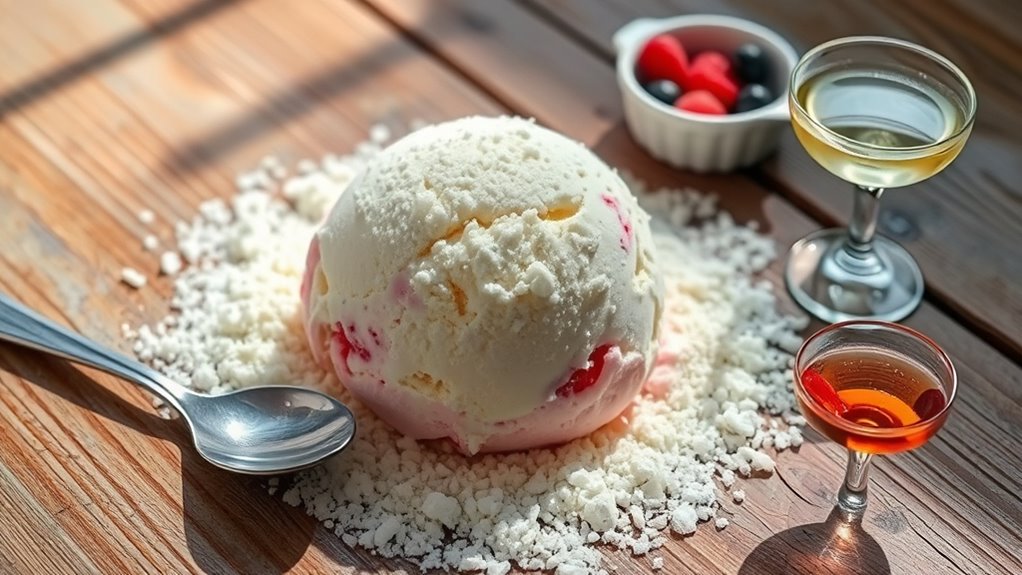
If you find yourself with grainy ice cream despite your best efforts, don’t throw it away just yet. You can use it in creative ways!
Thaw it out and blend it into delicious milkshakes; the mixing will smooth out the texture. Melted grainy ice cream makes a fantastic custard sauce, perfect for drizzling over brownies or cakes. Adding a bit of egg-enhanced richness can elevate your custard sauce even further. Additionally, consider using birthday cake ice cream for a unique flavor twist in your custard sauce that everyone will love.
Consider incorporating it into French toast or bread pudding recipes, where the sweetness can shine through while masking the graininess. Layer small portions of grainy ice cream in a parfait with other frozen treats to disguise any texture issues.
Finally, serve it topped with crunchy ingredients to distract from the graininess and enhance your dessert experience! You might even enjoy it alongside Dirt Cups, where the playful presentation can help mask the texture issues.
Frequently Asked Questions
Is Grainy Ice Cream Safe to Eat?
Yes, grainy ice cream is safe to eat. The graininess usually comes from ice crystal formation or lactose crystallization, which isn’t harmful.
While the texture mightn’t be what you expect, you can still enjoy it. If you notice graininess, it’s best to eat it sooner rather than later to prevent further texture changes.
To make it more enjoyable, consider blending it into milkshakes or other desserts.
What Causes Sandy Texture in Ice Cream?
They say good things come to those who wait, but sandy ice cream can feel like a letdown.
The gritty texture you’re experiencing is likely due to lactose crystallization. When lactose concentration exceeds its solubility, larger crystals form, creating that unpleasant mouthfeel. You might find this more noticeable in flavored varieties.
To prevent this, manage your lactose levels and consider using stabilizers to keep your ice cream smooth and enjoyable.
How to Get Rid of Grainy Texture in Ice Cream?
To get rid of the grainy texture in your ice cream, soften it slightly and process it in a food processor to break down larger ice crystals.
You can also mix in crunchy ingredients like nuts or cookie bits to help mask any grit.
If it’s due to lactose crystallization, melt the ice cream, add a starch, cook it into a pudding, and then re-freeze for a smoother consistency.
How Do You Make Grainy Ice Cream Smooth?
You’ve got the world’s most avant-garde ice cream, complete with a grainy texture that could rival sandpaper.
To transform it into something smoother, try softening it slightly and processing it in a food processor. If that doesn’t do the trick, mix in a stabilizer like cornstarch and re-freeze.
You can also re-churn it in smaller batches or serve it with toppings to distract from the texture.
Enjoy your masterpiece!
Conclusion
So, the next time you scoop into a bowl of grainy ice cream, remember that it could stem from improper emulsification or ice crystal formation. Coincidentally, you might find that experimenting with your ice cream-making techniques not only prevents graininess but can lead to delightful new flavors. Don’t let a little texture ruin your treat; instead, embrace the opportunity to create something even better. After all, every scoop is a chance to learn and enjoy!




